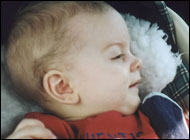Children in Large Families May Get Smaller Share of Health Care
Children living with many siblings or with adults in addition to their parents visit the doctor less often and use fewer prescriptions than children in more typical families, according to a new analysis.
The findings are not due to demographic or socioeconomic factors, parental education, child-rearing experience or children’s health status, say authors Alex Chen, M.D., at Children’s Hospital Los Angeles and Jose’ Escarce, M.D., at the University of California, Los Angeles.
The authors attribute the results to finite parental resources. “As there are more demands on a parent’s time and money … each child may receive less,” said Chen.
“Policies that provide support for working parents … may enable them to take their children for care,” concludes the study in the current issue of Health Services Research.
The authors analyzed data from a nationally representative survey on the use of medical care. The survey included 26,401 American youngsters under 18 living in two-parent families or single-mother families. There were not enough single-father families to include in the study. 
The data indicate that children of single mothers receive less care than those in two-parent families; however, these differences can be explained by other family traits such as poverty and lack of health insurance.
In contrast, children in families with four or more other children make only about four-fifths as many visits to doctor’s offices or emergency rooms as otherwise similar single-parent families. The effect of a large family on a child’s prescription drug use rivaled the effect of being uninsured and was larger than that of poverty.
The presence of nonparental adults - such as grandparents or a single-mother’s boyfriend - is also linked to less health care for children in the household.
The study notes that the data did not shed light on the health consequences of the difficult choices that many parents face. Nevertheless, said Chen, it’s clear that “today’s health care is very complicated, and it takes a lot of time and energy to get what you need.”
More family leave days may enable working parents to take their children for needed care, suggest the authors. They also say that health care providers should also monitor children with many siblings and those in cohabiting households more closely.
Simplified application and income certification processes for Medicaid would also go a long way toward helping overloaded parents, says Matthew Davis, M.D., a University of Michigan pediatrician and internist with additional expertise in public policy. “That’s an arena in which some states have really innovated with regard to online applications and other means of keeping children enrolled,” he said.
Chen AY, Escarce JJ. Effects of family structure on children’s use of ambulatory visits and prescription medications. Health Services Research (online), 2006.
Health Behavior News Service
Revision date: June 14, 2011
Last revised: by Sebastian Scheller, MD, ScD